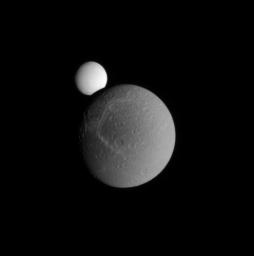
|
Occulting Enceladus
- Click the image above for a larger view
- Full-Res JPEG (521 x 525) (8.3 kB)
- Full-Res TIFF (521 x 525) (274.0 kB)
Caption:
Enceladus peeks over the limb of Dione during a partial occultation.
Dione (1,123 kilometers, or 698 miles across), like most of Saturn's icy moons, has a rather bright, reflective surface. But Enceladus is far and away brighter. As the most reflective body in the Solar System, Enceladus returns to space about 99 percent of the visible light that strikes it.
The spray that issues from the geologically active south polar region of Enceladus (504 kilometers, or 313 miles across) coats the moon in fresh, white ice and replenishes Saturn's E ring.
Images like this are extremely useful for scientists, as they show both moons together at approximately the same solar illumination angle. This gives a reference point for researchers to compare data about how the moons reflect light when they are not seen together on the sky.
The image was taken in visible light with the Cassini spacecraft narrow-angle camera on Sept. 13, 2008. The view was acquired at a distance of approximately 877,000 kilometers (545,000 miles) from Dione and 1.2 million kilometers (740,000 miles) from Enceladus. Image scale is 5 kilometers (3 miles) per pixel on Dione and 7 kilometers (4 miles) per pixel on Enceladus.
Background Info:
The Cassini-Huygens mission is a cooperative project of NASA, the European Space Agency and the Italian Space Agency. The Jet Propulsion Laboratory, a division of the California Institute of Technology in Pasadena, manages the mission for NASA's Science Mission Directorate, Washington, D.C. The Cassini orbiter and its two onboard cameras were designed, developed and assembled at JPL. The imaging operations center is based at the Space Science Institute in Boulder, Colo.
For more information about the Cassini-Huygens mission visit http://saturn.jpl.nasa.gov/ . The Cassini imaging team homepage is at http://ciclops.org .
Cataloging Keywords:
| Name | Value | Additional Values |
|---|---|---|
| Target | Enceladus | Dione, E Ring, Saturn Rings |
| System | Saturn | |
| Target Type | Satellite | Ring |
| Mission | Cassini-Huygens | |
| Instrument Host | Cassini Orbiter | |
| Host Type | Orbiter | |
| Instrument | Imaging Science Subsystem (ISS) | |
| Detector | Narrow Angle Camera | |
| Extra Keywords | Grayscale, Occultation, Visual | |
| Acquisition Date | ||
| Release Date | 2008-10-28 | |
| Date in Caption | ||
| Image Credit | NASA/JPL/Space Science Institute | |
| Source | photojournal.jpl.nasa.gov/catalog/PIA10500 | |
| Identifier | PIA10500 | |
